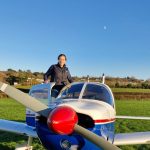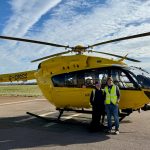Training for my night rating
I achieved my Private Pilot Licence (PPL) last summer with EFG Flying School out of Biggin Hill. My next challenge was to achieve my night rating. After a delay following a continued period of low cloud, the moment arrived for me to embark upon my first nighttime dual flying lesson! Headtorch at the ready, the excitement of seeing pretty lights twinkling from up above was both exciting and daunting! I completed the preflight checks before taxiing even more cautiously than normal owing to the restricted nighttime visibility.
Taking off with my instructor, Carmen Gardien, in a Piper PA28, we routed over Kent and towards the Sussex coastline, turning west towards Lydd. My first impressions of flying at night – truly magical. Nighttime flying is quite special, seeing the twinkling lights outlining the urban landscapes and the moonlight glimmering on water features was a captivating experience. Flying towards the southern coastline only accentuated this feeling. Spotting distant lights on a somewhat distorted horizon turned into a guessing game of aircraft or ship out at sea.
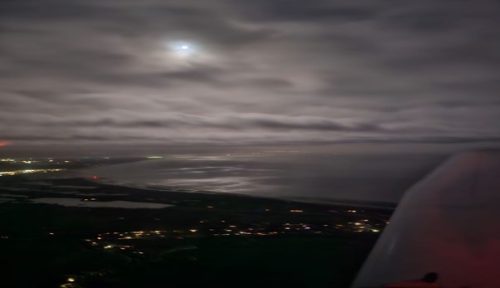
Sussex coastline
The approach to Lydd Airport was visually different to daytime. The concentration to join the circuit never felt so intense. When flying in daylight, we use suitable visual reference points to aid our approach to airfields; however, at night, it is very different. The initial landing required some guidance. The visibility of the runway was distorted and there were no centreline runway lights to aim for. This meant we had a few interesting practice touch-and-go landings. On this night, the circuit involved flying downwind over the sea. Dungeness power station was my reference point to ensure I turned in suitable time onto base. After a decent circuit practice, it was time to head back to Biggin Hill.
I decided to do my remaining training at Southend Airport. For my next lesson, I practiced a navigation route along the northern Kent coast, before crossing the Thames estuary and over to Southend controlled airspace. After my previous flight to Lydd, which on reflection seemed to be very dark, I thought flying to Southend – an area more built up and therefore brighter – would make finding the airport a lot easier. I could not have been more wrong! The airport nestled within a myriad of lights which required more concentration and attention to reference points than ever.
On this night, the circuit was busy. It was so busy that Air Traffic Control (ATC) instructed me to perform left and right-hand circuits, orbits and a go-around, owing to heavy traffic flow. A busy night indeed yet very useful exposure to the changing nature of circuit training and the necessity of responding swiftly in a busy circuit pattern. After I had practiced multiple circuits, my instructor asked me if I wanted to go solo. I would have jumped at the opportunity; however, due to feeling tired from a long day, I opted to complete it next time. This was a decision I did not regret as an aircraft around the time I would have been going solo experienced an engine failure, and those in circuit had to perform multiple orbits. The aircraft landed safely but required assistance to get off the runway. As pilots, we all know the significance and impact safety has personally and on others. I am so glad that I decided to defer going solo until my next flight. This was 26 November. I was unlucky with the December weather on my allocated bookings and together with the festive break, I did not make it back up until early January and my attempts of going solo were delayed.
After a freezing cold patch and a few snow flurries down south, the moment to complete my night rating finally came! It could not have been any more scenic. The climb out of Biggin Hill and up over fields covered in snow highlighted the illuminated landmarks. The night sky was calm, clear and would hopefully make for quieter nighttime circuit practice at Southend… or so I thought!
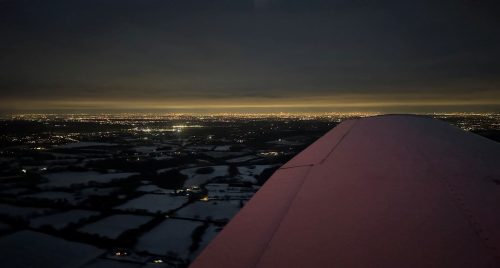
Climb out of Biggin Hill
The runway at Southend is pretty! The approach to the runway after base and then onto final is stunning. After a few practice touch-and-go landings, it was time for me to go solo. It was such a wonderful feeling easing into my second circuit and admiring the night skyline. Whilst I was flying there came an announcement from an A320 EasyJet of their intention to depart. Shortly afterwards, ATC instructed me to orbit. I said out loud to myself “I’ve got this” and before I knew it, it was my time to be approaching the runway to land, with a night rating in the bag.
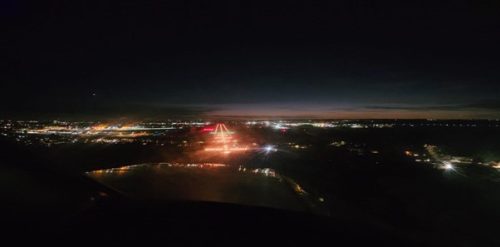
Southend approach
Nighttime flying was a truly captivating experience and most definitely worth waiting for. I thoroughly recommend obtaining the night rating. It a rewarding achievement, given the level of technical skill and enhanced human performance required to identify personal fatigue and the impediments of night vision to safely operate an aircraft at night.
Natasha Rowson






